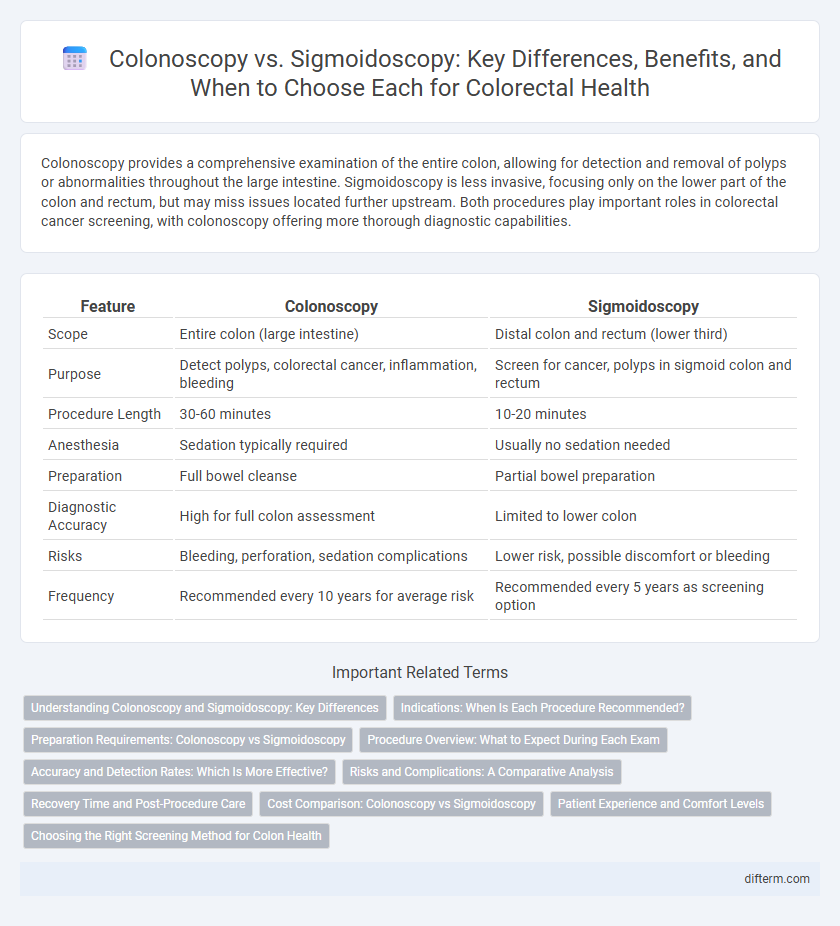Colonoscopy provides a comprehensive examination of the entire colon, allowing for detection and removal of polyps or abnormalities throughout the large intestine. Sigmoidoscopy is less invasive, focusing only on the lower part of the colon and rectum, but may miss issues located further upstream. Both procedures play important roles in colorectal cancer screening, with colonoscopy offering more thorough diagnostic capabilities.
Table of Comparison
| Feature | Colonoscopy | Sigmoidoscopy |
|---|---|---|
| Scope | Entire colon (large intestine) | Distal colon and rectum (lower third) |
| Purpose | Detect polyps, colorectal cancer, inflammation, bleeding | Screen for cancer, polyps in sigmoid colon and rectum |
| Procedure Length | 30-60 minutes | 10-20 minutes |
| Anesthesia | Sedation typically required | Usually no sedation needed |
| Preparation | Full bowel cleanse | Partial bowel preparation |
| Diagnostic Accuracy | High for full colon assessment | Limited to lower colon |
| Risks | Bleeding, perforation, sedation complications | Lower risk, possible discomfort or bleeding |
| Frequency | Recommended every 10 years for average risk | Recommended every 5 years as screening option |
Understanding Colonoscopy and Sigmoidoscopy: Key Differences
Colonoscopy is a comprehensive diagnostic procedure that examines the entire colon and rectum using a flexible tube with a camera, allowing detection and removal of polyps and other abnormalities. Sigmoidoscopy, by contrast, focuses only on the rectum and lower part of the colon, leading to a less invasive exam with typically shorter preparation and recovery times. Understanding these distinctions is crucial for informed decision-making in colorectal cancer screening and gastrointestinal disease diagnosis.
Indications: When Is Each Procedure Recommended?
Colonoscopy is recommended for comprehensive evaluation of the entire colon, especially in patients with a family history of colorectal cancer, unexplained gastrointestinal symptoms, or positive fecal occult blood tests. Sigmoidoscopy is preferred for screening lower colon issues such as rectal bleeding, localized inflammation, or monitoring patients with a history of distal colon polyps. Both procedures aid in early detection of colorectal cancer but are chosen based on the extent of examination needed and patient's risk factors.
Preparation Requirements: Colonoscopy vs Sigmoidoscopy
Colonoscopy requires thorough bowel preparation, including a clear liquid diet and strong laxatives to cleanse the entire colon, ensuring optimal visibility for comprehensive examination. Sigmoidoscopy involves a less intensive preparation, often limited to an enema that clears only the lower part of the colon, making it quicker and easier to complete. The extent of preparation directly correlates with the scope of the procedure, with colonoscopy demanding more rigorous cleansing due to its examination of the entire large intestine.
Procedure Overview: What to Expect During Each Exam
Colonoscopy involves inserting a long, flexible tube with a camera into the entire colon, providing a complete visualization and allowing for biopsy or polyp removal during the procedure. Sigmoidoscopy uses a shorter scope to examine only the rectum and lower part of the colon, typically causing less discomfort and requiring less extensive bowel preparation. Both procedures usually require sedation, but colonoscopy tends to have a longer examination time and recovery due to its comprehensive nature.
Accuracy and Detection Rates: Which Is More Effective?
Colonoscopy offers higher accuracy and superior detection rates compared to sigmoidoscopy due to its ability to examine the entire colon, identifying more polyps and early-stage cancers. Sigmoidoscopy, limited to the distal colon, misses lesions in the proximal sections, reducing its effectiveness in comprehensive colorectal cancer screening. Studies reveal colonoscopy's sensitivity exceeds 95%, whereas sigmoidoscopy's detection rate is significantly lower, especially for right-sided adenomas.
Risks and Complications: A Comparative Analysis
Colonoscopy carries higher risks such as perforation (approximately 0.1-0.3%) and bleeding, particularly when polyps are removed, compared to sigmoidoscopy, which has a lower complication rate due to its limited scope. While both procedures may cause discomfort, sedation-related adverse effects occur more frequently with colonoscopy. Infection rates are minimal for both, but thorough bowel preparation and sterile techniques are critical to minimizing potential complications during either examination.
Recovery Time and Post-Procedure Care
Colonoscopy typically requires a longer recovery time of 24 to 48 hours due to sedation effects and the more extensive examination of the entire colon, while sigmoidoscopy generally allows for a quicker recovery within a few hours since it examines only the lower part of the colon. Post-procedure care for colonoscopy involves monitoring for signs of bleeding or perforation and following dietary restrictions, whereas sigmoidoscopy post-care usually includes minimal dietary changes and watching for mild cramping. Both procedures necessitate clear communication with healthcare providers about any severe pain, fever, or persistent bleeding to ensure prompt medical attention.
Cost Comparison: Colonoscopy vs Sigmoidoscopy
Colonoscopy typically costs between $1,000 and $3,000, while sigmoidoscopy ranges from $300 to $800, reflecting significant differences in procedure complexity and scope. Insurance coverage and geographic location can further influence out-of-pocket expenses for both procedures. Cost-effectiveness varies depending on the patient's risk profile and the intended diagnostic purpose, with colonoscopy offering a more comprehensive examination but at a higher price point.
Patient Experience and Comfort Levels
Colonoscopy offers a comprehensive examination of the entire colon, often requiring sedation to enhance patient comfort during the procedure. Sigmoidoscopy, being less invasive and limited to the lower colon, typically results in quicker recovery times and reduced discomfort without full sedation. Patient experience varies, with colonoscopy preferred for thorough diagnosis despite longer preparation and sedation, while sigmoidoscopy is favored for routine screenings due to its simplicity and minimal discomfort.
Choosing the Right Screening Method for Colon Health
Colonoscopy provides a comprehensive examination of the entire colon, detecting polyps and early signs of colorectal cancer with higher accuracy compared to sigmoidoscopy, which only inspects the lower part of the colon. Risk factors such as age, family history, and previous findings determine the appropriate screening method, with colonoscopy recommended for individuals at higher risk or requiring full colon evaluation. For average-risk patients seeking less invasive screening, sigmoidoscopy may be sufficient, but colonoscopy remains the gold standard for thorough colon health assessment.
Colonoscopy vs sigmoidoscopy Infographic

 difterm.com
difterm.com